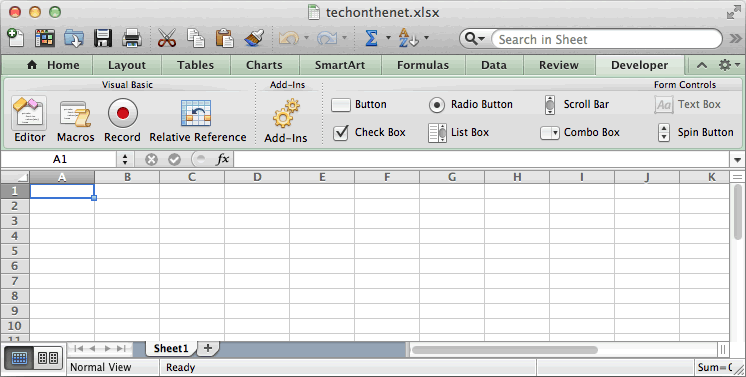고정 헤더 영역
상세 컨텐츠
본문

The first option on the View menu of the Office 2011 for Mac Visual Basic Editor (VBE) is the Code option, which is grayed out until you make at least one Code window visible in the VBE. A common way to open a new code window is to use Insert→Module. A module is like a new word processing document window — it’s blank. I want Excel to run a macro automatically when the Excel file is opened. Place the code in (or call it from) the Workbook_open event of the ThisWorkbook module in the VB editor. Or simply name your macro Auto_Open.
To automate a repetitive task so that you can do the task again with a single click, you can use the Developer tab in Excel for Mac to record and run a macro. You can also create a macro by using the Visual Basic Editor in Microsoft Visual Basic for Applications (VBA) to write your own macro programming code. If you no longer use a macro, you can delete it.
- When I open the VBA editor in Excel 2011 for Mac, the editor opens several dozen module windows. I have to spend the next 20 seconds hitting cmd-W repeatedly to close all of the windows.
- Windows shortcuts in dark gray on the left, Mac shortcuts in white on the right. See also: The 54 Excel shortcuts you really should know and Excel shortcuts on the Mac.
- The Visual Basic for Applications editor, also called the VBA editor, VB editor, or VBE, is an interface for creating scripts. VBA is the programming language that’s used to create these scripts. Visual Basic is a full-featured programming language, but you’ll only need to learn some of the basics to get the hang of VBA scripts in Excel.
Record a macro


When you record a macro, the macro recorder records all the steps required to complete the actions that you want your macro to perform. These steps can include typing text or numbers, clicking cells or commands on the ribbon or on menus, formatting, selecting cells, rows, or columns, and dragging your mouse to select cells on your spreadsheet. The commands for recording, creating, and deleting macros are available on the Developer tab on the Ribbon.
If the Developer tab is not available, do the following to display it:
Select Excel > Preferences > Ribbon & Toolbar.
Under Customize the Ribbon, select Main Tabs and then check Developer.
Click Save and then close Excel Preferences.
On the Developer tab, click Record Macro.
Note: To create a macro from VBE, click Visual Basic. In the code window of the module, type the macro code that you want to use.
In the Macro name box, enter a name for the macro.
The first character of the macro name must be a letter. Subsequent characters can be letters, numbers, or underscore characters. Spaces cannot be used in a macro name; an underscore character works well as a word separator. If you use a macro name that is also a cell reference, you may get an error message that the macro name is not valid.
In the Store macro in list, select This Workbook.
In the Shortcut key box, type any lowercase letter or uppercase letter that you want to use.
Note: The shortcut key will override any equivalent default Excel shortcut key while the workbook that contains the macro is open.
In the Description box, type a description of the macro and click OK.
Complete recording your macro.
On the Developer tab, click Stop Recording.
Delete a macro
On the Developer tab, click Macros.
In the list, click the macro that you want to delete, and click the delete button.
How To Open Vba In Excel
See Also
How To Open Vba Editor In Outlook 2016
If you just purchased 2008 I would take back and get 2011 (unless you still using a PowerPC Machine).
If that is your situation , and you truly using 12.0. you need to update. You must run each update one at a time.
Repair permissions and use Fontbook to check for Duplicates (choose resolve conflicts)
One of these may work for 2008:
http://word.mvps.org/Mac/fontweeding.html
http://www.officeformachelp.com/office/font-management/
It's my understanding there are a very few Excel Macros written by excel (4?) that do work. But modern Macros, all VBA doesn't work





댓글 영역